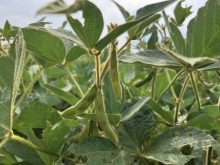Phytophthora root rot was major concern to growers in the province 25 to 30 years ago, when Roundup Ready soybeans were just emerging on the marketplace, Bt corn was in its infancy, and GPS-based yield monitors were available primarily as after-purchase combine enhancements.
Why it matters: Agronomists noted there were hot spots in the province for Phytophthora last growing season.
Today, those innovations are commonplace, if not obsolete. But Phytophthora root rot, while not a troublesome disease like soybean cyst nematode (SCN) or sudden death syndrome (SDS), is still aggravating growers, if not in the field, then in understanding the newest available genetics to fight the disease.
Read Also

The forced Japanese-Canadian farmers of the Second World War
Manitoba’s sugar beet farms drew on displaced Japanese-Canadians from B.C. during the Second World War
The disparity between the potential yield loss due to Phytophthora and the diminished familiarity of the disease among growers is undoubtedly frustrating.
It’s not that it’s no longer a concern, despite the comparatively low levels of yield loss, it’s that there are other –and bigger –disease challenges.
According to statistics gathered by the Crop Protection Network in 2022, SCN, SDS and seedling diseases (Fusarium, Pythium, Phomopsis and Rhizoctonia) ranked much higher in yield loss than Phytophthora (see Table 1 on page 20).
Septoria brown spot and Sclerotinia (white mould) also rated higher (although losses due to the latter may have jumped considerably in 2023).
Shifted focus
The concern about SCN and SDS as primary soybean diseases is warranted, especially given the link researchers have established between the two. In a wet year such as 2023, it was to be expected that white mould might vault into third place ahead of several others.
Yet some agronomists and certified crop advisors (CCAs) heard more about Phytophthora root rot this past growing season, not as a wide-spread infestation but more as a disease with some “hot spots” in different parts of the province.
The genetics front is one aspect of managing for Phytophthora that has arguably taken a step back in the past 10 or 15 years. Part of that is due to the activity of the Rps1 resistance gene: it’s done such a good job of fighting Phytophthora, it’s created a learning gap about newer varieties with improved genetics.
Some growers contacted their agronomists or CCAs in 2023, asking about Phytophthora’s return and more pointedly, the differences between an Rps1k or an Rps1c and an Rps3a.
Early in 2024, Marijke Vanderlaan, an agronomist with Syngenta Canada, fielded a grower’s questions about Phytophthora. She agrees the disease slipped in its ranking compared to the late 1990s or early 2000s, believing a lot of that distraction has come with the rise of SCN and SDS.

“Yes, we’re hearing that it’s still here and I never thought it had gone away, it’s just one of those hidden yield robbers like SCN,” says Vanderlaan, who works in crop protection. “But SDS is a lot more showy and exciting, visually, so Phytophthora root rot is still causing yield loss, yet it’s a lot harder to quantify.”
Genetics have improved, she adds, as has field tolerance due to enhanced screening to drop susceptible varieties. Another practice that may be increasing the amount of Phytophthora infection is the trend where growers are planting corn but interrupt that job to get their soybeans in once the ground is fit, then return to finish their corn.
Stacking the deck
In Ontario, Race 25 is now the predominant race of Phytophthora, which has developed in the past 20 years. Older genes such as Rps1c and Rps1k have little activity on Race 25, and that’s been one driver of seed companies to stack genes, similar to trait stacking in corn hybrids to address above- and below-ground insect pests.
There’s also the approach that advocates higher use of seed treatments to protect against disease development.
“One of the newer Rps genes is the 3a gene and you’ll see it if you look through seed guides,” says Vanderlaan, adding that Syngenta Canada has several varieties with that gene.
“They’ll still put the 1k or 1c in there, but with the Rps3a.”
Another consideration is the soil types where Phytophthora can be a problem. Clay soils found in Lambton, Haldimand, Niagara and parts of Middlesex are suitable for the development of the disease.
Growers are less likely to see it in regions with loamy, silty or sandy soils.
As for the need for a remedial or reminder on Phytophthora root rot and its potential to affect yields, Vanderlaan refers to a “perfect storm”, wondering if it’s a case of a newer gene with an older issue, which doesn’t rank as high as other disease concerns.
They’re called “hidden yield robbers” for a reason, and that lack of visibility also affects manageability.
“Typically, growers are not coming to us with complaints about those issues unless they get really bad,” she says. “With white mould they might say ‘I lost 20 bushels because of that.’ If that’s the case, the number one thing you’re going to look at in your seed guide is white mould susceptibility, and you know growers are there with SCN. So, there is some education being done around the importance of the Rps3a but it’s lower on the priority list.”
Location specific
Just as with weed species and insect pests, diseases can be very specific in terms of where or how they’re a problem. White mould is usually more common in parts of Eastern Ontario because cooler temperatures favour the disease. But for Jonathan Zettler, Phytophthora root rot was more of an issue in his region of midwestern Ontario this past growing season. His view mirrors Vanderlaan’s that Phytophthora’s become that “out-of-sight, out-of-mind” yield-robber.
White mould was certainly a visible disease problem in 2023 and that it’s been aided by conversations and attempts to provide resources geared to workable solutions.
But Phytophthora isn’t getting those same “talking points”.
“It seems to be more of an issue, mainly because growers aren’t talking about it,” says Zettler, an independent CCA who operates Fieldwalker Agronomy Ltd., near Clifford.
“To some extent, growers and crop inputs advisors don’t know what they’re looking for when they see it.”
In the area of Wellington, Bruce, Huron and Perth counties he serves, the impact of Phytophthora is underestimated, to the point where it’s a bigger disease issue than SDS or SCN, even though those are starting to make their appearances.
“Soybean disease management is critical to maintaining profitability, and longer rotations away from soybeans tend to yield the best, resulting in higher profitability,” adds Zettler.















